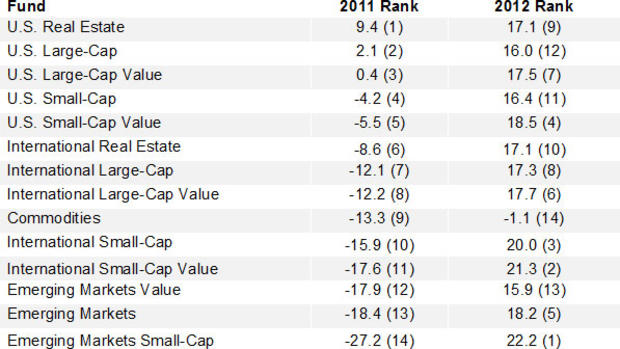Grasping what the market can teach you
(MoneyWatch) We recentlytook a look at some of the lessonsthe markets taught us last year. Now, we'll dive into the remainder of the lessons, which help provide the right way to look at the returns we experienced (or possibly missed out on).
- The most important lesson for investors
- Should you dump your international stocks?
- Great economies don't usually mean great returns
One of the major lessons we learned in 2012 was one we learn almost every year. Hedge funds should be avoided as investments. In 2012, the HFRX Global Hedge Fund Index returned 3.5 percent, and the index returned just 1.7 percent over the past 10 years. The table below sums up the evidence pretty well.
The HFRX Global Hedge Fund Index underperformed all the major equity asset classes in 2012. A portfolio equally weighting the 10 domestic and international stock asset classes would have returned 16.7 percent. And a 60 percent stock/40 percent bond portfolio with those weights for stock allocation would have returned 10.3 using five-year Treasuries. Given the freedom to move across asset classes that hedge funds tout as their big advantage, one would think that "advantage" would show up. The problem is that the efficiency of the market, as well as the costs of the efforts, turns that supposed advantage into a handicap.
For the 10-year period, the same stock portfolio described above would have returned 10.9 percent. And the 60 percent stock/40 percent bond portfolio with those weights for the stock allocation and five-year Treasuries for the bonds would have returned 9.4 percent.
Last year's returns are meaningless this year
The historical evidence shows that we tend to chase performance: buying yesterday's winners and selling yesterday's losers. This causes investors to buy high and sell low -- not exactly a recipe for investment success.
Unfortunately, while there are streaks in asset class returns, they occur randomly relative to expectations. The streaks have no more meaning than streaks at the craps table -- a good return in one year doesn't predict a good return the next. In fact, great returns lower future expected returns and below average returns raise future expected returns. This is why it's important to stick to your investment plan like a postage stamp to a letter.
Below are the 2011 and 2012 returns for various asset classes.* As you can see, returns were all over the place. 2011's worst performer turned into the best performer in 2012. Emerging markets value stocks jumped 32 percentage points in 2012 but actually fell a spot when ranked.
Crowds are a bad sign
I have to thank my good friend and fellow author Bill Bernstein for this one: "Asset classes are like tourist destinations; while they're undiscovered, they're fabulous. After they get found, not so much."
These words of wisdom certainly can be applied to what has been called the Yale Model. When David Swensen, Yale's Chief Investment Officer, first implemented it a quarter century ago, it was a fabulous idea. But now many pension plans and university endowments are chasing investments in private equity, hedge funds, timber and private real estate. That's usually a sign that if there ever was an opportunity to generate excess returns relative to the risks, it's no longer there. As evidence, I offer the following:
In his Oct. 12 "New York Times" article, James Stewart reported that college and university endowment returns for the most recent fiscal year simply weren't good: "In many cases, they warrant a grade of 'C' at best, and in some cases, an 'F.'" Even more disconcerting is that for the 2011 fiscal year large, medium and small endowments all underperformed a simple mix of 60 percent stocks and 40 percent bonds over one-year, three-year and five-year periods. The 91 percent of endowments with less than $1 billion in assets underperformed in every time period since records have been maintained. Given the weak results being reported this year, that underperformance is likely to be even more pronounced when the fiscal year 2012 results are included.
Legendary investors can struggle too
The returns for John Paulson's Advantage Plus fund used to be exceptional. From 2007 through 2010 his Advantage Plus returned, 163 percent, 38 percent, 21 percent and 17 percent. Then in 2011, Advantage Plus lost 53 percent. In 2012 Paulson had a chance to right the ship and prove the previous year was an anomaly. It improved, but still finished the year down 19 percent.
It's easy to spot last year's winners. Identifying ahead of time next year's winners has proven to be a loser's game: the odds of doing so are so low that it's imprudent to try.
2013 will surely provide investors with more lessons, many of which will be remedial courses. And the market will provide you with opportunities to make investment mistakes. You can avoid making mistakes by knowing your financial history and having a well-thought-out plan. And reading Investment Mistakes Even Smart Investors Make will provide you with some of the wisdom needed to avoid making them.
* Asset classes represented as follows: U.S. real estate by Dow Jones U.S. Select REIT Index, U.S. large-cap by S&P 500 Index, U.S. large-cap value by Russell 1000 Value Index, U.S. small-cap by Russell 2000 Index, U.S. small-cap value by Russell 2000 Value Index, international real estate by S&P Global ex U.S. REIT Index, international large-cap by MSCI EAFE Index, international large-cap value by MSCI EAFE Value Index, commodities by Dow Jones-UBS Commodity Index, international small-cap by MSCI EAFE Small Cap Index, emerging markets value by MSCI Emerging Markets Value Index, emerging markets by MSCI Emerging Markets Index, emerging markets small-cap by MSCI Emerging Markets Small Cap Index.



